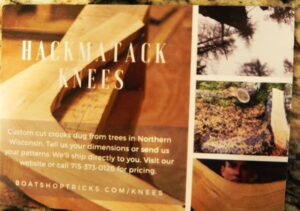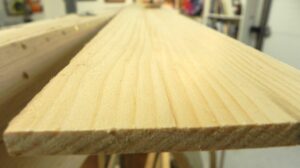Some primal urge took over and I start building yet another guideboat. I fear building boats is in my family tree. With the last name Fisher it is likely that there is a strong family connection with boats and boat building. Then too, my father built a small sailboat that he and my mother raced on the Chesapeake Bay. You have read about my Uncle Don and the Whitehall he built.
This time around I will build a guideboat as closely as I can to how the old master builders did in the late 1800’s. I will use hackmatack roots for the stems and ribs and quarter sawn Eastern white pine for the planking.
How do I source these rather exotic materials? Fortunately I have a friend who can help. Josh and I became close friends in the year 2000. This was the year my wife Fran and I spent in the Adirondacks. I volunteered at the Adirondack Museum in several different capacities. Halley Bond, then the Museum’s curator of the Museum’s small boat collection, decided to initiate a guideboat building living exhibit. A boat builder would construct a guideboat on site before the Museum visitor’s very eyes. Josh had been hired as an intern, having just graduated from the Newport Rhode Island boat building school. So he assumed the role of builder. Since I had built a guideboat, I became a docent. I would answer the visitor’s questions so that Josh could devote his full attention to boat building.
Josh left the Adirondacks after his internship was over and set up shop in northern Wisconsin right near Lake Superior. He knew that there was a need for hackmatack knees for boat building and other uses. There had been a fellow who had a corner on the knee market; Newman, who called his business Newman’s Knees. Tragically he was killed in a logging accident.
Josh found that hackmatack tress were numerous in his area. They thrived in the boggy conditions found there. He met a logger who was harvesting the hackmatack trees but had no interest in the knees. The logger agreed to cut the trees chest high so that the roots were preserved.
Having learned from Newman’s demise, Josh uses a remote controlled power takeoff on his pick-up truck to pull the roots out of the ground. Here is the flyer for his root business.

The flyer says “Custom cut crooks from trees in Northern Wisconsin. Tell us your dimensions or send us your patterns, We’ll ship directly to you. Visit our website or call (715) 373-0126 for pricing.
BOATSHOPTRICKS .COM/KNEES
I took Josh up on his offer. It turns out that he already had a set of my plans. The hull facing surface of the ribs he sent me fit perfectly to my rib patterns. All I had to do was trim the interior facing part of the rib and round it. I used spoke shaves, large and small, and a scraper, to do that.

He also sent stems, fore and aft. These needed a little trimming and the rabbet cut in them.
Josh said he could supply me quarter sawn clear eastern white pine 3/8″ thick. It turns out that he knew some very old white pine trees that had their tops blown out in winter storms. They were nearby and were scheduled to be harvested.
The stock he sent were 1/4″ thick by at least 4″ wide and up to 12 feet long. Since Josh had been involved in building guideboats he knew how much stock to send.
Here is an edge view of the quarter sawn stock.

Note that the grain is not perpendicular to the top and bottom surfaces. This would be the case with truly quarter sawn stock. The grain in this stock lies at an angle to the surfaces. This is called riff cut and was preferred by the old timer boat builders.
Next time I will introduce someone who will help me build this boat. We will start to assemble the boat piece by piece.